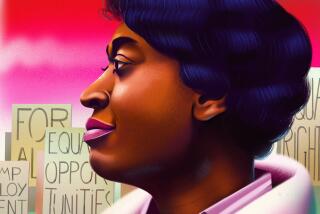A Milestone of Change -- but Full Equality Remains Far Away
- Share via
Forty years ago, 250,000 men, women and children gathered in front of the Lincoln Memorial on Aug. 28, 1963. The March on Washington for Jobs and Freedom was organized by some of the most renowned civil rights leaders of the day -- Bayard Rustin, A. Philip Randolph and Martin Luther King Jr., among others. It brought together disparate unions, every major religious organization and, most important, ordinary citizens of all colors, ages, faiths and classes. And it occasioned King’s still stunning “I Have a Dream” speech. In its widening wake of social consciousness, Congress passed the Civil Rights Act of 1964, the Voting Rights Act of 1965 and the Fair Housing Act of 1968, forever changing this country.
Dorothy Height, then the president of the National Council of Negro Women and director of the YWCA Office on Racial Justice, sat on the Lincoln Memorial platform in 1963. Like so many others who were there, she is still most impressed by the diversity of the crowd and its singular sense of purpose.
“There was a kind of spiritual dimension that had no denomination, no color, no sex,” she told me recently in a phone interview. “We had to change the system, we had to change the laws.”
Despite its iconic status, many of my contemporaries -- blacks born toward the end of the 1960s -- sometimes regard the March on Washington only as a precious artifact, an achievement then with less than lasting relevance now.
It is not hard to understand this generational reserve -- social consciousness has lost ground in public policy; inequities persist. According to the Census Bureau, of the 36 million people who identify themselves as “African American or African American in combination with one or more races,” nearly 23% live in poverty and 11% are unemployed. Per capita, blacks earn $509 a week compared with $631 for whites, and the numbers of black men enrolled in college rival their prison ranks.
Back in 1963, a rising tide of national moral decency made it impossible for most Americans to ignore the cumulative grotesqueries of Strom Thurmond’s segregationist filibustering, Bull Connor’s fire hoses and police dogs and the assassination of Medgar Evers. Poverty rates for blacks in the United States were roughly twice that of whites. And although Brown vs. Board of Education had outlawed school segregation nearly 10 years earlier, the majority of black children could expect to achieve only substandard educations at public schools that were still functionally -- if not legally -- segregated.
Height, now 91, just published a memoir, “Open Wide the Freedom Gates.” She makes clear that doubts are not only the province of my generation.
Even as “whites only” signs came down across the country, a sense of frustration accompanied the achievements. Many who marched to change the laws never saw those changes make their own lives materially better.
The reasons the disappointment persists are complex, and for many blacks looking within for answers, some of the explanations are uncomfortable.
Young African American professionals compete against each other for limited spaces in corporations and educational institutions. Idolatry of pop celebrities and materialism has invaded our value systems. Weak participation in our democracy doesn’t help -- the Federal Election Commission reports that only 47% of eligible African Americans under age 44 voted in the last presidential election, compared with roughly 53% of whites the same age.
As Height says, “Many of our young people have gone through open doors and don’t know how those doors got opened.”
Among many blacks born after the major gains of the civil rights movement in the 1960s, contrition accompanies the lingering disillusionment. One of my friends, a partner at a major consulting firm, recently said, “I always feel I should be doing more.” He invoked W.E.B. Dubois’ theory of the “talented tenth” -- that blacks who are able to achieve success would be able to help others who had yet to do so. That “hasn’t worked much better than trickle-down economics,” my friend continued. “Ten percent of a small minority is still not enough of a critical mass. What needs to be done exceeds the supply of people able -- and willing -- to help others.”
Perhaps, however, it is the loss of wider unity that is ultimately most damaging to full realization of King’s dream.
“The righteous indignation, that unified determination to open wide those gates of freedom -- that was there 40 years ago, but it is not there now,” Height says.
Still, she is hopeful, and the hope displayed in 1963 has lessons for my generation. The symbolism of the vast, diverse crowd at the Lincoln Memorial endures as a watershed moment and perhaps an inspirational blueprint.
Height counsels a return to the proven formula: “People need to be a part of organizations. We have to redouble all efforts to get people to vote and clarify that freedom is not invincible. You have to be a part of groups who see their purpose as helping to make the Constitution, and all of the laws of the land, work for all of the people -- not just for some.”
The enduring legacy of the march is that racial and social inequities are not solely the problems of isolated special interests. If the challenges for my generation are in some ways more subtle than they were years ago, we can still afford to leave no one behind -- women, gays, children, the poor, new immigrants. There’s room for everyone who wants to join the coalition. Justice for one race benefits every race; the responsibility to do the work rests with everyone.
In the lesser-known words of Dr. King’s speech: “1963 is not an end, but a beginning ... we must forever conduct our struggle on the high plane of dignity and discipline.”
More to Read
Sign up for Essential California
The most important California stories and recommendations in your inbox every morning.
You may occasionally receive promotional content from the Los Angeles Times.










